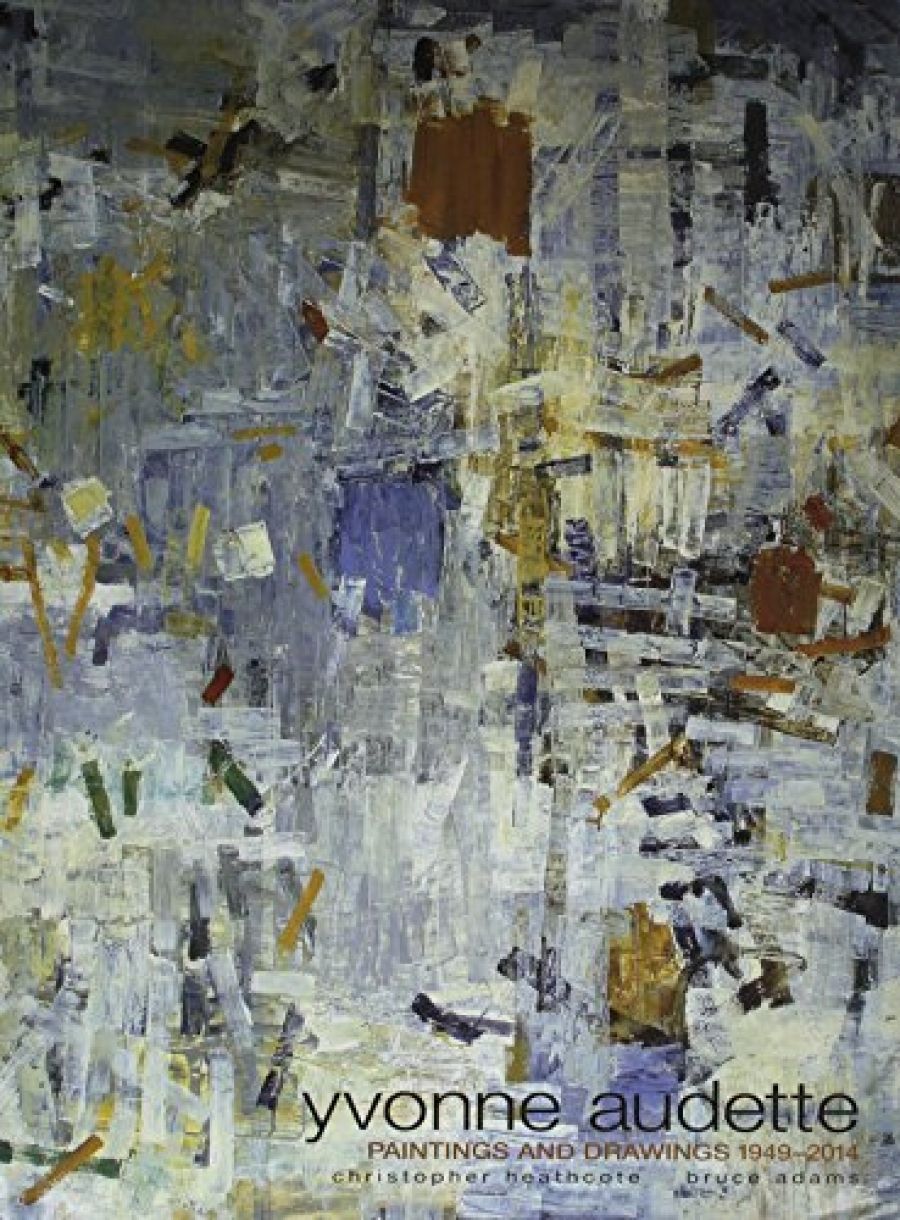
- Free Article: No
- Contents Category: Art
- Review Article: Yes
- Article Title: Momentary Tremors
- Online Only: No
- Custom Highlight Text:
It’s something of a shame, I suppose, but an enduring cliché emanating from Sofia Coppola’s critically acclaimed film Lost in Translation is the term itself – used currently to describe social encounters where language really is a barrier to communication, or abused in glib dismissals of ailing relationships or fraught encounters. But this is the term that sprang to mind when I was reading this book and considering the deft ways in which each of the writers has contextualised Yvonne Audette’s art, but has not lost in their translations of her practice the lyricism and understatement in her work, and the ultimately mysterious internal impulses that have driven Audette through five decades of creative enterprise. For some viewers, Audette’s is, or could be, an uneasy art. The pleasant surprise in this book is its balance of scholarship against its evocation of the poetics and introspection of an artist’s vision and visual life.
- Book 1 Title: Yvonne Audette
- Book 1 Subtitle: Paintings and drawings
- Book 1 Biblio: Macmillan, $99hb, 240pp
Audette has committed herself to the painting and drawing of abstract works that can be subtle or boldly declarative, and that have their sources in music, climate, landscape and the traditions, ecologies and architectures of other cultures, particularly European. This is the third important publication on the work of Audette in the past five years. The first of these was the Queensland Art Gallery’s catalogue for the exhibition, Yvonne Audette: Abstract Paintings of the 1950s & 1960s. The curator of the exhibition, Julie Ewington, ensured that the first comprehensive account of Audette’s career would position this under-regarded artist in the disparate social and cultural milieux that conditioned her education and art practice, and that it would situate Audette within the complex matrix of twentieth and twenty-first-century Australian art history.
Audette is one of a number of Australian artists – several of them women – whose careers have been the subject of recent evaluations and reassessments: Agnes Goodsir, Clarice Beckett and Margot Lewers, to name a few. In her catalogue essay, Ewington noted that Audette ‘was located precisely in an in-between generation of artists placed after the efflorescence of modernist art from the 1920s to 1940s, in which women had been leaders … and before the upsurge in activity by women trained in the post-war expansion of art education in the late 1960s and early 1970s’.
This Macmillan publication takes its lead from Ewington’s elaboration of the broader art-historical and social contexts for Audette’s art. After Chris Wallace-Crabbe’s warm and welcoming preface, three extensively researched essays penetrate Audette’s professional life and her art. I say professional life because the emphasis of the book is on the importance of the work and the situations in which it was made. There are no excursions into Audette’s private life, but what this book makes clear is the profound interconnection of art and life in the world that Audette inhabits and that she has constructed around her.
Christopher Heathcote and Bruce Adams have had long professional associations with Audette’s work, and Audette’s meticulous memory and her artist’s notes and journals augment their detailed research. Heathcote’s essay focuses on the early years of Audette’s life, but moves swiftly to the awakening of her consciousness to the possibilities and realities of life as an artist. His study moves through Audette’s initial training at the Julian Ashton School in Sydney to the various night and weekend classes that she would attend in her ongoing immersion in contemporary art. It was during this initial phase of development that Audette formed some of her most enduring and influential relationships, with artist-mentors such as John Passmore and Godfrey Miller, and with fellow students such as John Olsen and Peter Upward.
Heathcote emphasises Audette’s international travels and the formative experiences of her life in New York, where she lived and studied from 1952 to 1955. Audette immersed herself in the New York art world at a moment of extraordinary change in the aesthetic programmes of a generation of young artists who were developing the kinds of abstract visual forms with which Audette felt such an affinity.
In his examination of Audette’s later years, Adams elaborates on the study he contributed to the Queensland catalogue, and introduces the reader to the critical reception of Audette’s work. Adams draws on a range of European and Australian critics, whose arguments provide fascinating comparisons for how this expatriate artist’s works, so deeply embedded in modern European developments, could be seen in the context of painting in Australia in the 1950s and 1960s.
Gerard Vaughan and Kristy Grant have jointly written the third essay in this lavishly illustrated publication. Together they reveal Audette’s commitment to drawing and working on paper, and the dialogue between these notational forms and the intuitive, though carefully considered, layered constructions of her paintings. This is another valuable, superbly researched contribution to Australian art histories.


Comments powered by CComment